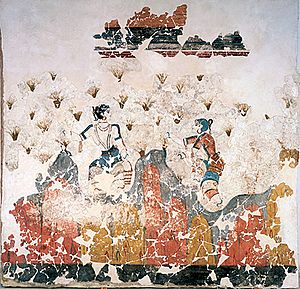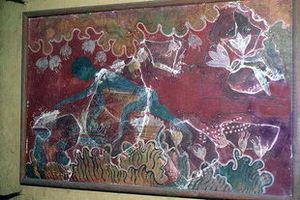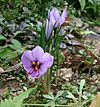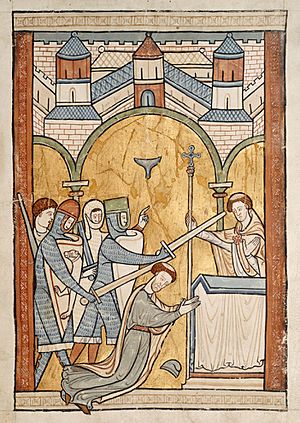History of saffron facts for kids
Saffron, a special spice, has been grown and used by people for over 3,500 years! It comes from the dried parts (called stigmas) of a flower called the saffron crocus (Crocus sativus). Throughout history, saffron has always been one of the most expensive things in the world. It has a slightly bitter taste, smells a bit like hay, and has a hint of metal. People have used saffron for cooking, making perfumes, dyeing clothes, and even as medicine.
The wild plant that saffron came from was probably Crocus cartwrightianus. This plant grew in Crete or Central Asia. While we're not completely sure where saffron first appeared, many believe it started in Iran (Persia). However, Greece, Mesopotamia, and even Kashmir have also been suggested as its birthplace. Today, the saffron crocus cannot reproduce on its own. It needs humans to plant its bulbs by hand. Scientists think that C. sativus might be a special version of C. cartwrightianus that was bred by people in Crete during the late Bronze Age to have longer stigmas.
People might have chosen C. cartwrightianus plants that had unusually long stigmas to create the saffron we know today. This new saffron crocus was first written about in an ancient Assyrian plant book around 700 BC. Since then, it has been traded and used for thousands of years. It was even used to treat about ninety different illnesses! The saffron plant slowly spread across Europe and Asia, and later reached parts of North Africa, North America, and Oceania.
Contents
What's in a Name? The Word "Saffron"
The word "saffron" comes from the Latin word safranum. This word then became safran in Old French in the 12th century. The French word was borrowed from the Arabic word za'farān, which came from the Persian word zarparān. In Persian, zarparān literally means "golden leaves."
The Latin word safranum also gave us the Catalan word safrà and the Italian word zafferano. But the Portuguese word açafrão and the Spanish word azafrán both came from the Arabic az-zaferán.
The Latin word crocus for the flower probably came from a Semitic language. It's thought to come from the Aramaic word kurkema, through the Arabic word kurkum, and then the Greek word krokos. All these words mean "yellowish." The Sanskrit word kunkumam might also be related to this Semitic term.
Ancient Times: Minoans, Greeks, and Romans
Crocus cartwrightianus is a type of flowering plant found in Greece and Crete. It's believed to be the wild ancestor of the saffron crocus we use today, Crocus sativus. Saffron probably first appeared in Crete. Even though some thought it came from Western or Central Asia, plant studies have shown this isn't true.
Saffron was very important in ancient Greece and Rome, from about 800 BC to 300 AD. The oldest known picture of saffron in ancient cultures is even older, from the Bronze Age. Frescoes (wall paintings) in the Knossos palace in Minoan Crete show young girls and monkeys picking saffron flowers. One of these paintings is in the "Xeste 3" building at Akrotiri, on the island of Santorini. These frescoes are likely from the 16th or 17th century BC. They show a Minoan goddess watching as flowers are picked and stigmas are collected, possibly to make medicine. Another fresco from the same place shows a woman using saffron to treat her bleeding foot. These "Theran" frescoes are the first clear pictures showing saffron being used as a herbal medicine. This Minoan town, which grew saffron, was later destroyed by a big earthquake and a volcanic eruption. The volcanic ash covered and helped save these important paintings.
Ancient Greek stories tell of brave sailors who went on long, dangerous trips to a faraway land called Cilicia. They went there to get what they believed was the world's most valuable saffron. The most famous Greek saffron story is about Crocus and Smilax. Crocus, a handsome young man, chased the nymph Smilax in the woods. Smilax liked his attention at first, but soon got tired of him. He kept chasing her, and she resisted. She used magic to turn Crocus into a saffron crocus flower. Its bright orange stigmas were seen as a lasting sign of his never-ending love.
In another version of the story, Crocus was the friend of the god Hermes. Hermes accidentally killed Crocus during a game with a discus. To remember Crocus, Hermes turned him into a saffron flower.
For ancient people around the Mediterranean Sea, saffron from the town of Soli in Cilicia was very valuable, especially for perfumes and ointments. However, historians like Herodotus and Pliny the Elder thought saffron from Assyria and Babylonia was the best for treating stomach or kidney problems. Greek saffron from the Corycian Cave on Mount Parnassus was also famous for its color and smell.
Cleopatra, the famous queen of ancient Egypt, used a quarter-cup of saffron in her warm baths. She loved its color and how it made her skin look. Egyptian healers used saffron to treat many stomach problems. They also treated urinary issues with an oil mixed with young saffron flowers and roasted beans.
In Greek and Roman times, the Phoenicians traded saffron widely across the Mediterranean. Their customers included perfume makers in Rosetta, doctors in Gaza, and people in Rhodes who carried saffron pouches to cover up bad smells from others at the theater. Big dye factories in Sidon and Tyre used saffron baths. Royal robes were dipped three times in deep purple dyes. For common people's robes, the last two dips were replaced with saffron, which gave a lighter purple color.
The ancient Greeks and Romans loved saffron as a perfume or air freshener. They sprinkled it in public places like royal halls, courts, and theaters. When Emperor Nero entered Rome, saffron was spread along the streets. Wealthy Romans took daily saffron baths. They used it as eye makeup, mixed saffron threads into their wine, threw it in the air in their homes and streets like potpourri, and offered it to their gods. Roman settlers took saffron with them when they moved to southern Roman Gaul. It was grown there a lot until an invasion in 271 AD. Some believe saffron only returned to France much later, with the Moors in the 8th century or with the Pope's court in Avignon in the 14th century.
Saffron in the Middle East and Persia

Saffron-based colors have been found in ancient cave paintings in modern-day Iraq, dating back 50,000 years! The Sumerians used saffron in their medicines and magic potions. They didn't grow saffron themselves but collected it from wild flowers. They believed that only divine power gave saffron its healing properties. This shows that saffron was traded over long distances even before the Minoan culture in Crete became powerful around 2000 BC. Saffron was also mentioned as a sweet-smelling spice over three thousand years ago in the Hebrew Bible:
Your lips drop sweetness like honeycomb, my bride, syrup and milk are under your tongue, and your dress had the scent of Lebanon. Your cheeks are an orchard of pomegranates, an orchard full of rare fruits, spikenard and saffron, sweet cane and cinnamon.
The Talmud, another ancient Jewish text, also says that saffron was among the spices used in the Ketoret, a special incense offered in the Temple in Jerusalem.
In ancient Persia, saffron was grown in places like Derbena and Isfahan as early as 1000 BC. Persian saffron threads have been found woven into old Persian royal carpets and burial cloths. Ancient Persian worshippers used saffron as a religious offering to their gods. They also used it as a bright yellow dye, a perfume, and a medicine. Saffron threads were scattered on beds and mixed into hot teas to help with sadness. Also, Persian saffron was dissolved in water with sandalwood to make a body wash after hard work in the hot Persian sun. Later, Alexander the Great and his army used a lot of Persian saffron during their trips in Asia. They mixed saffron into teas and ate saffron rice. Alexander himself put saffron in his warm bath water, just like Cyrus the Great. He believed it would heal his many wounds, and his belief in saffron grew with each treatment. He even told his soldiers to take saffron baths. The Greek soldiers, impressed by saffron's healing powers, kept using it after they went back to Macedonia.
Saffron in East and South Asia
There are different stories about how saffron first arrived in South and East Asia. Some stories, based on old Persian records, suggest that Persian rulers brought saffron to India. They wanted to fill their new gardens and parks with special plants, so they moved saffron plants across their empire. Then, in the 6th century BC, the Phoenicians started selling Kashmiri saffron using their wide trade routes. Once sold, Kashmiri saffron was used to treat sadness and to dye fabrics.
However, a traditional Kashmiri legend says that saffron first came in the 11th or 12th century AD. It says two traveling holy men, Khwaja Masood Wali and Hazrat Sheikh Shariffudin, came to Kashmir. They got sick and asked a local tribal leader for a cure. When the leader helped them, the two holy men supposedly gave him a saffron crocus bulb as a thank you. Even today, people offer prayers to these two saints during the saffron harvest season in autumn. The saints have a shrine and tomb dedicated to them in the saffron-trading village of Pampore, India. But a Kashmiri poet, Mohammed Yusuf Teng, disagrees. He says Kashmiris had been growing saffron for more than two thousand years. According to Hindu religion, Lord Krishna used to put a mark (Tilak) of Saffron on his forehead every day.
Ancient Chinese Buddhist stories tell another tale of saffron's arrival in India. According to legend, an Indian Buddhist missionary named Madhyântika was sent to Kashmir in the 5th century BC. When he arrived, he supposedly planted the first Kashmiri saffron crop. From there, saffron spread throughout India. Besides using it in food, saffron stigmas were also soaked in water to make a golden-yellow liquid used to dye fabric.
Some historians think saffron first came to China with Mongol invaders from Persia. Saffron is mentioned in an old Chinese medical book called Shennong Ben Cao Jing, which is thought to be from the 3rd century AD. But the Chinese referred to saffron as coming from Kashmir. A Chinese medical expert named Wan Zhen wrote that "The home of saffron is in Kashmir, where people grow it mainly to offer it to the Buddha." Wan also wrote about how saffron was used in his time: "The [saffron crocus] flower withers after a few days, and then the saffron is obtained. It is valued for its uniform yellow color. It can be used to flavor wine."
In more recent times, saffron growing has spread to Afghanistan, thanks to efforts by the European Union and the United Kingdom.
Saffron in Europe After Ancient Times
Saffron farming in Europe greatly decreased after the Roman Empire fell. For several centuries, saffron was rarely grown, or not at all. This changed when the Moorish civilization spread from North Africa to Spain and parts of France and southern Italy. One idea is that the Moors brought saffron bulbs back to the Poitiers area after they lost the Battle of Tours in 732 AD. Two centuries after they conquered Spain, the Moors planted saffron throughout the southern regions of Andalucia, Castile, La Mancha, and Valencia.
In France, saffron farming likely began in the 13th century. Crocus sativus was probably brought from Spain and the Middle East by travelers, traders, and knights. Its first uses are recorded in the southwest of the kingdom around 1250. It's very likely that kings and religious groups tried growing saffron by then, as it was rare, expensive, and in high demand, and it could be farmed in France. By the 14th century, saffron was widely used for spicing and coloring food, as shown in recipe books like the "Viandier de Taillevent." By the 15th century, local saffron farming was confirmed by taxes collected by the church, which shows how important saffron crops must have been. For example, in 1478, the saffron tax collected by the Bishop of Albi was 1/12th of the saffron produced.
The demand for saffron shot up when the Black Death (a terrible plague) hit Europe from 1347 to 1350. People who had the plague wanted saffron for medicine, but many farmers who could grow it had died. So, large amounts of saffron had to be brought in from outside Europe. The best saffron from Muslim lands was not available to Europeans because of wars like the Crusades. So, places like Rhodes became key suppliers to central and northern Europe. Saffron was even a cause of conflict between the old noble families and the new, wealthy merchants. The "Saffron War," which lasted fourteen weeks, started when a shipment of 800 pounds of saffron was stolen by nobles. That amount would be worth over $500,000 today! The shipment was eventually returned, but in the 13th century, trade was often hit by pirates. Thieves in the Mediterranean Sea would often ignore gold and instead steal saffron being shipped from Venice and Genoa to Europe.
To avoid such problems, the town of Basel planted its own saffron bulbs. Several years of big and profitable saffron harvests made Basel very rich compared to other European towns. Citizens tried to protect their wealth by making it illegal to take saffron bulbs out of the town. Guards were even posted to stop thieves from picking flowers or digging up bulbs. But ten years later, the saffron harvests became smaller. Basel eventually stopped growing the crop.
The center of European saffron trade then moved to Nuremberg. Merchants from Venice continued to control sea trade, bringing saffron from Sicily, France, Spain, Austria, Crete, Greece, and the Ottoman Empire. Fake saffron was also sold: some was soaked in honey, mixed with marigold petals, or kept in damp cellars to make it heavier and cheaper. Annoyed Nuremberg authorities passed the Safranschou law to clean up the saffron trade. People who faked saffron were fined, put in prison, and even executed. England was next to become a major producer. One idea is that the crop spread to eastern England in the 14th century during the reign of King Edward III. In the years that followed, saffron was grown for a short time across England. Norfolk, Suffolk, and south Cambridgeshire were especially known for it. Rowland Parker wrote about saffron farming in the village of Foxton in the 16th and 17th centuries, "usually by people holding a small amount of land." An acre planted with saffron could bring in a kingly £6, making it "a very profitable crop, provided that plenty of unpaid labor was available."
In France, saffron production became very important in the 17th and 18th centuries, reaching a few tons. By then, saffron farming had spread throughout the entire Kingdom. Saffron was especially grown in Albigeois, Angoumois, Gascony, Gâtinais, Normandy, Périgord, Poitou, Provence, and Quercy. Its mysterious decline started during the 18th century, possibly due to widespread fungal diseases destroying bulbs and crops, very cold winters, and competition from other countries around the Mediterranean Sea.
In England, saffron growing continued only in the light, well-drained, chalky soils of northern Essex. The Essex town of Saffron Walden got its name because it was a center for growing and trading saffron. Its original name was Cheppinge Walden, and the name was changed to show how important the crop was to the townspeople. The town's coat of arms still features flowers from the saffron crocus. However, as England moved out of the Middle Ages, new religious ideas and new lands conquered abroad put English saffron's use and farming at risk. People with strict religious views preferred simpler, unspiced foods. Saffron was also a crop that needed a lot of work, which became a problem as wages and the value of people's time increased. And finally, many new and cheaper spices from the Far East arrived because of the growing spice trade. This meant that English people, and other Europeans, had many more choices for flavoring their food.
This trend was noted by Reverend William Herbert. He collected samples and information about the saffron crocus. He was worried about the steady decline in saffron farming during the 17th century and the start of the Industrial Revolution. The introduction of easy-to-grow crops like maize (corn) and potatoes in Europe, which took over land once used for saffron, also didn't help. Plus, the wealthy people who usually bought saffron were now more interested in exciting new things like chocolate, coffee, tea, and vanilla. Only in the south of France, Italy, and Spain, where saffron harvest was a very old tradition, did significant farming continue.
Saffron in North America
Saffron came to the New World when thousands of people from Alsace, Germany, and Switzerland, like the Anabaptists and Dunkards, escaped religious persecution in Europe. They settled mainly in eastern Pennsylvania, in the Susquehanna River valley. These settlers, known as the Pennsylvania Dutch, were widely growing saffron by 1730. The first saffron bulbs were brought to America in a trunk by German members of a Protestant church called the Schwenkfelder Church. Schwenkfelders loved saffron and had grown it back in Germany. Pennsylvania Dutch saffron was soon successfully sold to Spanish settlers in the Caribbean. Its high demand meant that its price on the Philadelphia market was set equal to that of gold!
However, the War of 1812 destroyed many of the merchant ships that carried American saffron abroad. Pennsylvania saffron growers were left with too much saffron, and trade with the Caribbean markets never recovered. Despite this, Pennsylvania Dutch growers found many uses for the now plentiful saffron in their own cooking, such as in cakes, noodles, and chicken or trout dishes. Saffron farming continued into modern times mainly in Lancaster County, Pennsylvania.
|
See also
 In Spanish: Historia del azafrán para niños
In Spanish: Historia del azafrán para niños







